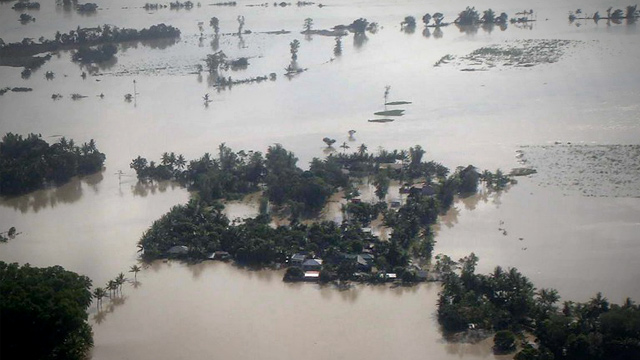SUMMARY
This is AI generated summarization, which may have errors. For context, always refer to the full article.

MANILA, Philippines – The people of Calinog in the province of Iloilo were used to occasional typhoons, until tropical storm Quinta hit the Western Visayas region on Dec 26, 2012.
“The people were shocked, my team was surprised,” Alberto Cercado Jr, head of the municipal disaster risk reduction and management office (MDRRMO), told Rappler in Filipino.
Cercado said the people in his town have always been prepared during typhoons, but he now feels that they could only do so much. Not only do they lack equipment and the budget to purchase them, they grapple with the magnitude of the need and the complexity of the requirements to withstand the impact of climate change.
A World Bank study released in June 2013 revealed that climate change will lead to more intense typhoons, higher sea levels, and storm surges in the coming decades. It poses growing threats to agricultural productivity and to development gains in general, according to the study.
Strongest typhoon
Cercado observed that unlike previous typhoons, tropical storm Quinta pounded the region with continuous rain. Rivers swelled and overflowed causing flashfloods and landslides.
Quinta — the strongest typhoon that hit the province since Frank in 2008 — affected at least 400,000 people in Iloilo, according to the Regional Disaster Risk Reduction and Management Council-VI (RDRRMC-VI).
It left 24 people dead and destroyed more than 2,000 houses across the province. It also cost at least P291 million and P350 million in damage to agriculture and infrastructure, respectively.
Cercado felt times are indeed changing and the climate is becoming more unpredictable. So are the tools that are needed to mitigate the impact of disasters that come with it.
‘Naked eye’
Cercado recalled that when Quinta hit his town, his team did not have even the basic instruments, such as water level and landslide sensors, which are helpful in reducing disaster risk.
“We could see how fast the level of river water was rising. We only monitored it visually,” Cercado said in Filipino.
At least 26 of the 42 towns in the province, including Calinog, are prone to flooding, the Iloilo Provincial Disaster Risk Reduction and Management Office (PDRRMO) reported.
“Many communities falling under the Jalaur river basin are prone to climate-induced hazards such as landslides and floods that cause substantial losses in lives and property almost every year,” Climate Change Commission (CCC) vice chairperson Lucille Sering said in a statement.
“They also eradicate economic advances that were made in the local economies,” Sering added.

Project ReBUILD
Sering, together with the provincial government of Iloilo, recently spearheaded the launching of a project that hopes to address the needs and dilemma of local planners like Cercado.
Dubbed “Resilience Capacity Building for Cities and Municipalities to Reduce Disaster Risks from Climate Change and Natural Hazards” (ReBUILD), the project seeks to prepare Iloilo so that when typhoons like Quinta strike, the province can withstand their impact.
The project aims to produce results at the level where the impact of disasters are directly felt – local government units. The US$1.22-million project which is funded by New Zealand Aid Programme (NZAP) will introduce the “necessary enabling policy environment, mechanisms, systems and tools to address disaster risks,” Sering said.
It particularly plans to put in place mitigating measures that include the following:
- Early warning systems in communities
- Operational contingency plans
- Re-engineered infrastructure
- Zoning regulations based on risks
Climate expenditure review
In the long run, ReBUILD also attempts to bridge gaps in climate policy efforts that hamper their effectiveness. A World Bank report recently revealed difficulties in monitoring climate-related activities across sectors and levels of government.
“The national, sectoral, and local development plans and policies are not fully aligned with the NCCAP (National Climate Change Action Plan),” the report indicated.
The report, which conducted a public expenditure and institutional review, also emphasized that the support that LGUs receive from the national government remains insufficient.
“Financing gaps for knowledge and capacity development may slow implementation progress,” the report stressed.
The Climate Change Act mandated the national government to provide technical and financial support to LGUs in formulating local climate action plans (LCCAPs).
Increasing climate budget
Budget Secretary Florencio Abad stressed that the allocated funds for climate change programs have been steadily rising at an average of 26% annually since 2009. The increase is bigger than the 6% growth of the national budget.
But Cercado has not felt the increase. He said he continues to make do with a meager budget for his town’s disaster risk reduction efforts.
Citing an example, Cercado said his office currently has P100,000 to purchase hand-held radios that cost P9,500 each. They are helpful in warning the people to evacuate when there are threats of flooding.
For now, only the heads of various agencies will receive the gadgets due to budgetary constraints. The town has 59 barangay captains in remote areas, who also need the tools, according to Cercado.
But they will have to wait until the next budget cycle. Or even the one after. – Rappler.com
Add a comment
How does this make you feel?





There are no comments yet. Add your comment to start the conversation.